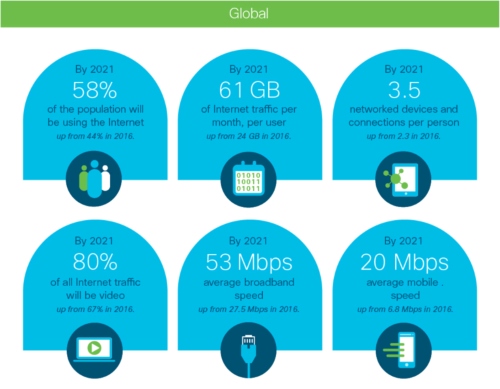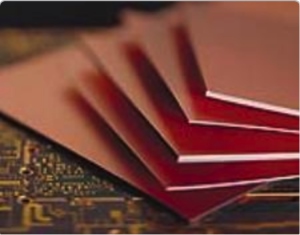
Published
by Rogers Corporation
Advanced Electronics Solutions
You think the pace of technology innovation is fast now, wait til you see what’s going to happen with 5G wireless. 5G will drive an Internet of Things (IoT) ecosystem of intelligent, fully connected sensors and devices, capable of improving economies small and large, and further blurring geographical borders.
According to the 2017 Cisco Mobile Visual Networking Index (VNI), 5G networks will be able to support advanced applications such as remote surgery, immersive experiences through virtual and augmented reality, autonomous cars, and so on.” All are game changers in their industries.
By 2021, it is predicted there may be as many as 25 billion 5G-capable devices and connections globally. The first few years of IoT deployment will run mostly on LTE networks using NarrowBand IoT (NB-IoT) and LTE M. But 5G growth is expected to be fast.
The Cisco VNI report states, “While 4G was the network that made smartphones prolific as a personal infotainment device, 5G is going to be network of the IoT. 5G will be capable of offering a new high bandwidth benchmark of 1 Gbps or higher and sub 1 ms latency. Operationally, 5G’s support for dynamic resource allocation and application prioritization will accommodate a variety of M2M devices, including those that require very low bandwidth.”
Today’s cellular networks operate in the 700 MHz to 2.6 GHz bands. Mobile service providers have introduced 4.5G and 4.9G technology to improve speeds immediately. 5G fixed wireless access will follow shortly; Verizon has been running trials in 11 cities. 5G mobile technology will follow shortly; AT&T estimates as soon as late 2018.
5G, when it arrives, is expected to handle far more traffic at much higher speeds than current cell network base stations. This requires new technologies, including millimeter waves (mmWaves), massive MIMO (multiple-input multiple-output), beamforming, and full duplex. Let’s take a look at a few of these key developments.
Millimeter Wave Spectrum
5G networks will be based on millimeter wave technology that can run in the underutilized portions of the 10-300 GHz band. Some cellular providers have begun to use mmWaves to send data between stationary points, such as base stations. Providers are considering the next step, using millimeter waves to connect mobile users to nearby base stations.
They are called mmWaves because the wavelength varies in length from 1 to 10 mm vs. the radio waves that serve today’s wireless devices, which measure tens of centimeters in length. Because these signals are shorter, there are hurdles to overcome. The higher frequencies carry more data, but are easily blocked by buildings and foliage, and sometimes even rain.
Sub-6 GHz Spectrum
Certain frequencies under Sub-6 GHz will be defined as 5G frequencies by 3GPP. That means these defined frequencies will be included in 5G standards and will apply to all countries.
A wide range of 5G trials are underway across the globe. China Mobile recently demonstrated the first 5G remote driving technology using a consumer car. They also completed a commercial Massive MIMO deployment that attained speeds of 2 Gbps.
In Massive MIMO, a high number of antennas, potentially hundreds, are incorporated into advanced chips that are smaller, deliver more processing power, and use less battery. The large number of antennas helps minimize signal loss and energy consumption, and can mitigate obstruction issues by steering signals in specific directions.
The Challenge of High Frequency Materials
Designers of these high frequency devices need to balance cost, weight, size, and radiation characteristics (such as gain, beamwidth, side-lobe levels, polarization). High frequency circuit materials deliver the performance needed by wireless base stations, satellite antennas, and network servers and storage.
PCB materials with dielectric constant (Dk) values of about 2.8 to 3.5 are preferred for sub-6 GHz and millimeter wave circuit applications. The consistency of the Dk across a circuit board can also be an important concern at these frequencies since variations in the Dk can introduce variations in the signal phase. Performance can also be affected by the composition of the PCB material.
Given this challenging set of requirements, what types of real-world materials are suitable for sub-6 GHz and millimeter-wave circuits?
The majority of initial 5G applications will be under 6 GHz, frequencies that are similar to those used in 3G and 4G materials. For such applications:
- Rogers’ RO4350B laminates provide tight control of Dk and low loss. They are rigid thermoset materials that do not use PTFE, but can achieve excellent RF/microwave performance over time and even at elevated temperatures.
- The RO4835 laminates are a high-performance material for high-frequency applications, but because it is not based on PTFE, it does not require special preparation (such as a sodium etch) to enable the formation of reliable plated through holes.
For microwave and millimeter wave applications:
- The RO4730G3™ UL 94 V-0 antenna-grade laminates are designed to meet present and future performance requirements in active antenna arrays and small cells, in 4G base transceiver stations (BTS) and Internet of Things (IoT) applications, as well as emerging 5G wireless systems. These flame-retardant (per UL 94V-0), thermoset laminate materials are an extension of Rogers’ dependable RO4700™ circuit materials, which are a popular choice for base station antennas. RO4730G3 laminates provide the low dielectric constant (Dk) of 3.0 favored by antenna designers, held to a tolerance of ±0.05 when measured at 10 GHz.
Other new technologies are being created to enable the IoT networks that will deliver valuable insight obtained from massive amounts of data:
- High temperature silicone materials serve as gaskets and seals, cushions, and thermal and acoustic insulation in demanding and remote environments.
- Laminated multilayer busbars provide efficient and compact connections for propulsion, auxiliary, and other IGBT based converters in connected car and connected rail systems.
5G and sub-6 GHz networks will impact every aspect of our lives. Finding the right balance of material performance and cost is a challenge, especially technologies that is are still being defined.
Tags:
5G, Wireless Infrastructure
Comments
Published on Aug 14, 2017

